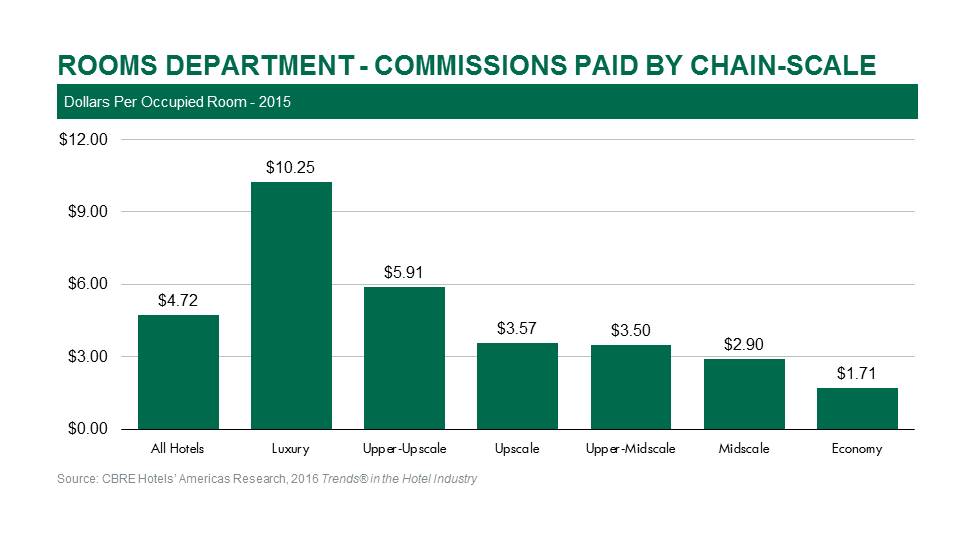By Robert Mandelbaum
The increasing incidence of intermediaries selling hotel rooms and other services is a major topic of discussion among U.S. hotel owners and operators. From online travel agents to convention housing companies, third-parties are placing themselves in between hotels and their guests during the sales process. Of course these intermediaries want to get paid, and therefore this has become a rising expense for hoteliers.
Per the Uniform System of Accounts for the Lodging Industry (USALI), payments to intermediaries are classified as commissions. In recognition of the rise in intermediaries, the 11th edition of the USALI stipulates two commission expense categories within the rooms department; one for commissions paid for the booking of transient business, and one for commissions paid for the booking of group business. The commissions paid within the rooms department cover sales made for not only guest room rentals, but for any other ancillary revenue associated with those guests. If, however, an intermediary secures business solely for the benefit of the food and beverage department (i.e. local catering business without guest room rentals), then the commission payment is recorded within the food and beverage department.
Not included in the rooms department commission expense category are payments made to agents for the rental of commercial space within a hotel. These commission payments are recorded as professional fees within the administrative and general department.
In recognition of the rise in intermediaries, CBRE Hotels’ Americas Research began to track commission payments within the rooms department starting in 2015. Our firm’s Trends® in the Hotel Industry database captures the combined commissions paid for both transient and group business. The following paragraphs summarize the magnitude of rooms department commission payments in 2015 for U.S. hotels.
A Significant Expense
On average, commission payments are the second largest expense within the rooms department, behind labor costs. This ranking does vary by property type. At limited-service and extended-stay hotels, the cost of providing complimentary meals exceeds commission payments. At resort properties, more money is spent on the laundry, linen, and supplies provided in the guest rooms.
Measured as a percent of revenue, commission payments averaged 3.0 percent of total rooms revenue in 2015. Unfortunately the metric we do not have access to is the percentage of rooms revenue subject to a commission payment. Therefore, we are unable to calculate the average commission rate charged by travel agents and other intermediaries.
Commissions calculated as a percent of rooms revenue were greatest at convention hotels (4.5%). This confirms the increased use of housing companies and other agencies by meeting planners. Historically, hotels would deal directly with the meeting planner, and for the most part not have to pay a commission.
Commissions paid as a percent of rooms revenue were lowest at extended-stay properties (2.1%). In this segment, it appears that hotel sales managers are still able to deal directly with the corporate travel executives booking the long-term stays. Given recent trends in the convention segment, extended-stay hotel owners and operators should monitor intermediary activity in their segment going forward.
The Dollar Amount
Because of the differences in room rates, the dollar value of the commission paid by a hotel is influenced by the average daily rate (ADR). Therefore, it is not surprising that commission payments measured on a dollar per occupied room (POR) basis tend to follow the ADRs achieved by the various property types and chain-scales.
In 2015, convention hotels recorded the highest commission POR payments among all the property types ($8.14), followed by resort hotels ($6.22). When analyzing commissions POR by chain-scale, luxury properties paid the most ($10.25). Not only do luxury hotels and resorts achieve high ADRs, their guests are most likely to use the services of a travel agent.
At the low end of commission POR payments are extended-stay ($2.13) and limited-service ($3.35) properties. These hotels achieve relatively low ADRs, and their guests may not be using intermediaries as much as other travelers.+
Looking Forward
In an effort to measure the impact of intermediaries on the financial performance of hotels, the American Hotel and Lodging Association’s Consumer Innovation Forum is working with several hotel franchising, ownership and management companies to establish metrics that measure the “total acquisition cost” of hotel revenue. Commissions are just one component of this equation. Other components include reservation fees, marketing costs, and other expense incurred to secure revenue.
At CBRE, going forward we will be able to monitor annual changes in the commissions paid to intermediaries. This will shed some light on the ability of hotels to control this cost by negotiating more favorable contracts with the intermediaries, or increasing the frequency of guests booking directly with the hotel.




